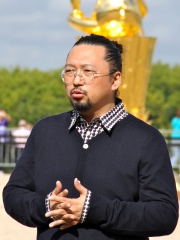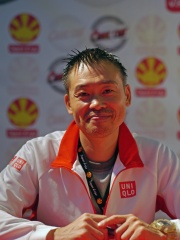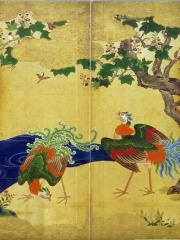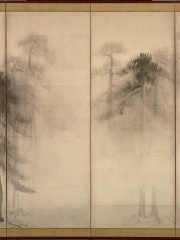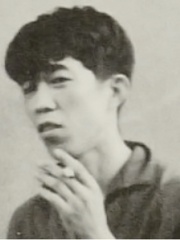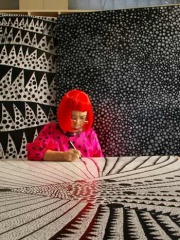
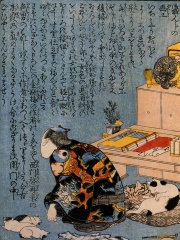

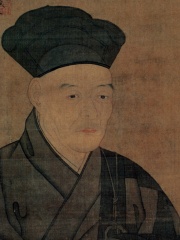
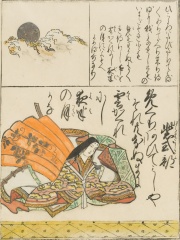
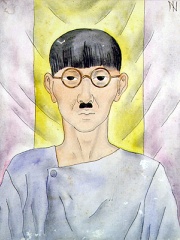
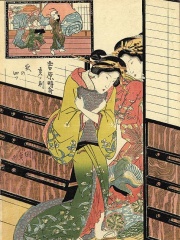
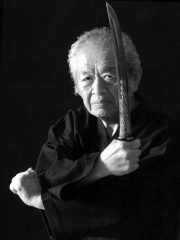
The Most Famous
PAINTERS from Japan
Top 10
The following people are considered by Pantheon to be the top 10 most legendary Japanese Painters of all time. This list of famous Japanese Painters is sorted by HPI (Historical Popularity Index), a metric that aggregates information on a biography's online popularity. Visit the rankings page to view the entire list of Japanese Painters.

1. Yayoi Kusama (b. 1929)
With an HPI of 75.40, Yayoi Kusama is the most famous Japanese Painter. Her biography has been translated into 47 different languages on wikipedia.
Yayoi Kusama (草間 彌生, Kusama Yayoi; born 22 March 1929) is a Japanese contemporary artist who works primarily in sculpture and installation. She is also active in painting, performance, video art, fashion, poetry, fiction, and other arts. Her work is based in conceptual art and shows some attributes of feminism, minimalism, surrealism, art brut, pop art, and abstract expressionism, and is infused with autobiographical, psychological, and sexual content. She has been acknowledged as one of the most important living artists to come out of Japan, the world's top-selling female artist, and the world's most successful living artist. Her work influenced that of her contemporaries, including Andy Warhol and Claes Oldenburg. Kusama was raised in Matsumoto, and trained at the Kyoto City University of Arts for a year in a traditional Japanese painting style called nihonga. She was inspired by American Abstract Impressionism. She moved to New York City in 1958 and was a part of the New York avant-garde scene throughout the 1960s, especially in the pop-art movement. Embracing the rise of the hippie counterculture of the late 1960s, she came to public attention when she organized a series of happenings in which naked participants were painted with brightly colored polka dots. She experienced a period in the 1970s during which her work was largely overlooked, but a revival of interest in the 1980s brought her art back into public view. Kusama has continued to create art in various museums around the world, from the 1950s onwards. Kusama has been open about her mental health and has resided since the 1970s in a mental health facility. She says that art has become her way to express her mental problems. "I fight pain, anxiety, and fear every day, and the only method I have found that relieved my illness is to keep creating art", she told an interviewer in 2012. "I followed the thread of art and somehow discovered a path that would allow me to live."

2. Utagawa Kuniyoshi (1797 - 1861)
With an HPI of 68.97, Utagawa Kuniyoshi is the 2nd most famous Japanese Painter. His biography has been translated into 34 different languages.
Utagawa Kuniyoshi (Japanese: 歌川 国芳, [ɯtaɡawa kɯɲiꜜjoɕi]; 1 January 1798 – 14 April 1861) was one of the last great masters of the Japanese ukiyo-e style of woodblock prints and painting. He was a member of the Utagawa school. The range of Kuniyoshi's subjects included many genres: landscapes, women, Kabuki actors, cats, and mythical animals. He is known for depictions of the battles of legendary samurai heroes. His artwork incorporated aspects of Western representation in landscape painting and caricature.

3. Utamaro (1753 - 1806)
With an HPI of 68.48, Utamaro is the 3rd most famous Japanese Painter. His biography has been translated into 48 different languages.
Kitagawa Utamaro (喜多川 歌麿; Japanese pronunciation: [ɯ.ta.ma.ɾo], c. 1753 – 31 October 1806) was a Japanese artist. He is one of the most highly regarded designers of ukiyo-e woodblock prints and paintings, and is best known for his bijin ōkubi-e "large-headed pictures of beautiful women" of the 1790s. He also produced nature studies, particularly illustrated books of insects. Little is known of Utamaro's life. His work began to appear in the 1770s, and he rose to prominence in the early 1790s with his portraits of beauties with exaggerated, elongated features. He produced over 2000 known prints and was one of the few ukiyo-e artists to achieve fame throughout Japan in his lifetime. In 1804 he was arrested and manacled for fifty days for making illegal prints depicting the 16th-century military ruler Toyotomi Hideyoshi, and died two years later. Utamaro's work reached Europe in the mid-nineteenth century, where it was very popular, enjoying particular acclaim in France. He influenced the European Impressionists, particularly with his use of partial views and his emphasis on light and shade, which they imitated. The reference to the "Japanese influence" among these artists often refers to the work of Utamaro.

4. Sesshū Tōyō (1420 - 1506)
With an HPI of 68.16, Sesshū Tōyō is the 4th most famous Japanese Painter. His biography has been translated into 43 different languages.
Sesshū Tōyō (雪舟 等楊; c. 1420 – August 26, 1506), also known simply as Sesshū (雪舟; Japanese pronunciation: [seꜜɕ.ɕɯː]), was a Japanese Zen monk and painter who is considered a great master of Japanese ink painting. Initially inspired by Chinese landscapes, Sesshū's work holds a distinctively Japanese style that reflects Zen Buddhist aesthetics. His prominent work captured images of landscapes, portraits, birds and flowers paintings, infused with Zen Buddhist beliefs, flattened perspective, and emphatic lines. Sesshū was born into the samurai Oda family (小田家) and trained at Shōkoku-ji temple in Kyoto, Japan, as a Zen monk. From his early childhood, Sesshū showed a talent for painting and eventually became widely revered throughout Japan as a wise, reputable Zen scholar, and the greatest painter priest of Zen-Shu. Sesshū worked in a painting atelier whilst training under Tenshō Shūbun (c. 1418–1463). But upon visiting China, his work took on a distinctive Chinese influence, merging Japanese and Chinese styles to develop his individualistic style of Zen paintings. Sesshū's influence on painting was so wide that many schools of art appointed him their founder. Sesshū's most acclaimed works are Winter Landscape (c. 1470s), Birds and Flowers (1420–1506) and Four Landscape Scrolls of the Seasons (1420–1506).
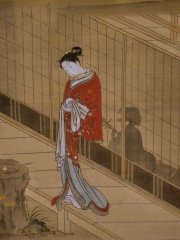
5. Suzuki Harunobu (1725 - 1770)
With an HPI of 66.78, Suzuki Harunobu is the 5th most famous Japanese Painter. His biography has been translated into 32 different languages.
Suzuki Harunobu (Japanese: 鈴木 春信; c. 1725 – 8 July 1770) was a Japanese designer of woodblock print art in the ukiyo-e style. He was an innovator, the first to produce full-color prints (nishiki-e) in 1765, rendering obsolete the former modes of two- and three-color prints. Harunobu used many special techniques, and depicted a wide variety of subjects, from classical poems to contemporary beauties. Like many artists of his day, Harunobu also produced a number of shunga, or erotic images. During his lifetime and shortly afterwards, many artists imitated his style. A few, such as Harushige, even boasted of their ability to forge the work of the great master. Much about Harunobu's life is unknown.

6. Hishikawa Moronobu (1618 - 1694)
With an HPI of 65.82, Hishikawa Moronobu is the 6th most famous Japanese Painter. His biography has been translated into 27 different languages.
Hishikawa Moronobu (Japanese: 菱川 師宣; 1618 – 25 July 1694) was a Japanese artist known for popularizing the ukiyo-e genre of woodblock prints and paintings in the late 17th century. He consolidated the works of scattered Japanese art styles and forged the early development of ukiyo-e.

7. Tsuguharu Foujita (1886 - 1968)
With an HPI of 65.11, Tsuguharu Foujita is the 7th most famous Japanese Painter. His biography has been translated into 23 different languages.
Léonard Tsuguharu Foujita (藤田 嗣治, Fujita Tsuguharu; 27 November 1886 – 29 January 1968) was a Japanese-French painter. After studying Western-style painting in Japan, Foujita travelled to Paris, where he encountered the international modern art scene of the Montparnasse neighbourhood and developed an eclectic style that borrowed from both Japanese and European artistic traditions. With his unusual fashion and distinctive figurative style, Foujita reached the height of his fame in 1920s Paris. His watercolour and oil works of nudes, still lifes, and self-portraits were a commercial success and he became a notable figure in the Parisian art scene. Foujita spent three years travelling through South and North America before returning to Japan in 1933, documenting his observations in sketches and paintings. Upon his return home, Foujita became an official war artist during World War II, illustrating battle scenes to raise the morale of the Japanese troops and citizens. His oil paintings won him acclaim during the war, but public perception of him became mixed following the Japanese defeat. Without significant prospects in the post-war Japanese art scene, Foujita returned to France in 1950, where he would spend the rest of his life. He received French nationality in 1955 and converted to Catholicism in 1959. His latter years were spent working on the frescoes for a small, Romanesque chapel in Reims that he had constructed. He died in 1968, shortly after the chapel officially opened. In France, Foujita is remembered as part of the années folles of the 1920s, but public opinion of him in Japan remains mixed due to his monumental depictions of the war. Retrospective exhibitions organised since 2006 in Japan have sought to establish Foujita's place in Japanese twentieth-century art history.

8. Kunisada (1786 - 1865)
With an HPI of 65.08, Kunisada is the 8th most famous Japanese Painter. His biography has been translated into 24 different languages.
Utagawa Kunisada (Japanese: 歌川 国貞; 1786 – 12 January 1865), also known as Utagawa Toyokuni III (三代 歌川 豊国, Sandai Utagawa Toyokuni), was a Japanese ukiyo-e artist. He is considered the most popular, prolific and commercially successful designer of ukiyo-e woodblock prints in 19th-century Japan. In his own time, his reputation far exceeded that of his contemporaries, Hokusai, Hiroshige and Kuniyoshi.

9. Masaaki Hatsumi (b. 1931)
With an HPI of 63.83, Masaaki Hatsumi is the 9th most famous Japanese Painter. His biography has been translated into 21 different languages.
Masaaki Hatsumi (初見 良昭; born Yoshiaki Hatsumi on December 2, 1931) is a Japanese martial artist best known as the founder of the Bujinkan organization and the 34th Togakure-ryū ninjutsu grandmaster (soke). He studied various martial arts before becoming the student and successor of Toshitsugu Takamatsu. Hatsumi dedicated his life to preserving and teaching nine traditional Japanese martial lineages, collectively known as Bujinkan Budō Taijutsu. Through books, seminars, and international outreach, he introduced authentic ninjutsu principles to a global audience. His teachings emphasize natural movement, adaptability, and spiritual discipline, shaping modern perceptions of historical ninja traditions. He is no longer active as a teacher and passed over his grandmaster titles to his students.
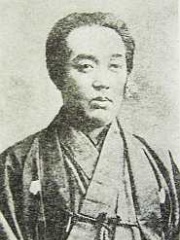
10. Yoshitoshi (1839 - 1892)
With an HPI of 63.66, Yoshitoshi is the 10th most famous Japanese Painter. His biography has been translated into 25 different languages.
Tsukioka Yoshitoshi (Japanese: 月岡芳年; also named Taiso Yoshitoshi 大蘇芳年; 30 April 1839 – 9 June 1892) was a Japanese printmaker. Yoshitoshi has widely been recognized as the last great master of the ukiyo-e genre of woodblock printing and painting. He is also regarded as one of the form's greatest innovators. His career spanned two eras – the last years of Edo period Japan, and the first years of modern Japan following the Meiji Restoration. Like many Japanese, Yoshitoshi was interested in new things from the rest of the world, but over time he became increasingly concerned with the loss of many aspects of traditional Japanese culture, among them traditional woodblock printing. By the end of his career, Yoshitoshi was in an almost single-handed struggle against time and technology. As he worked on in the old manner, Japan was adopting Western mass reproduction methods like photography and lithography. Nonetheless, in a Japan that was turning away from its own past, he almost singlehandedly managed to push the traditional Japanese woodblock print to a new level, before it effectively died with him. His life was summed up by John Stevenson: Yoshitoshi's courage, vision and force of character gave ukiyo-e another generation of life, and illuminated it with one last burst of glory. His reputation has only continued to grow, both in the West, and among younger Japanese, and he is now almost universally recognized as the greatest Japanese artist of his era.
People
Pantheon has 32 people classified as Japanese painters born between 1151 and 1965. Of these 32, 4 (12.50%) of them are still alive today. The most famous living Japanese painters include Yayoi Kusama, Masaaki Hatsumi, and Takashi Murakami. The most famous deceased Japanese painters include Utagawa Kuniyoshi, Utamaro, and Sesshū Tōyō.
Living Japanese Painters
Go to all RankingsYayoi Kusama
1929 - Present
HPI: 75.40
Masaaki Hatsumi
1931 - Present
HPI: 63.83
Takashi Murakami
1962 - Present
HPI: 62.75
Keiji Inafune
1965 - Present
HPI: 51.14
Deceased Japanese Painters
Go to all RankingsUtagawa Kuniyoshi
1797 - 1861
HPI: 68.97
Utamaro
1753 - 1806
HPI: 68.48
Sesshū Tōyō
1420 - 1506
HPI: 68.16
Suzuki Harunobu
1725 - 1770
HPI: 66.78
Hishikawa Moronobu
1618 - 1694
HPI: 65.82
Tsuguharu Foujita
1886 - 1968
HPI: 65.11
Kunisada
1786 - 1865
HPI: 65.08
Yoshitoshi
1839 - 1892
HPI: 63.66
Ogata Kōrin
1658 - 1716
HPI: 62.58
Kanō Eitoku
1543 - 1590
HPI: 62.39
Hasegawa Tōhaku
1539 - 1610
HPI: 61.59
On Kawara
1932 - 2014
HPI: 60.87
Overlapping Lives
Which Painters were alive at the same time? This visualization shows the lifespans of the 14 most globally memorable Painters since 1700.

